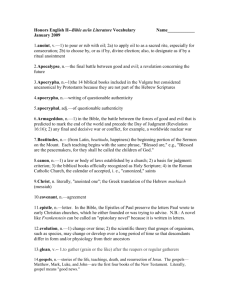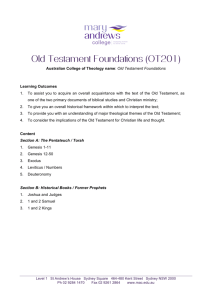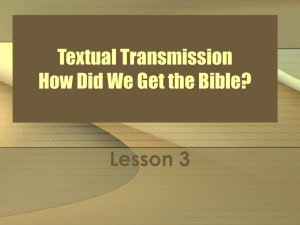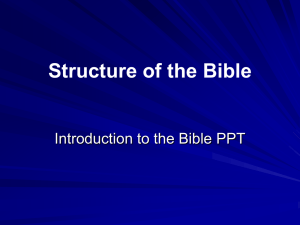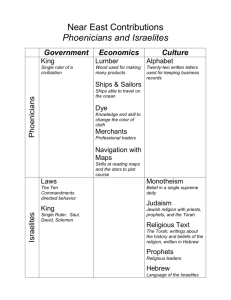What You Should Know-OT1 Old Testament Survey-Final
advertisement
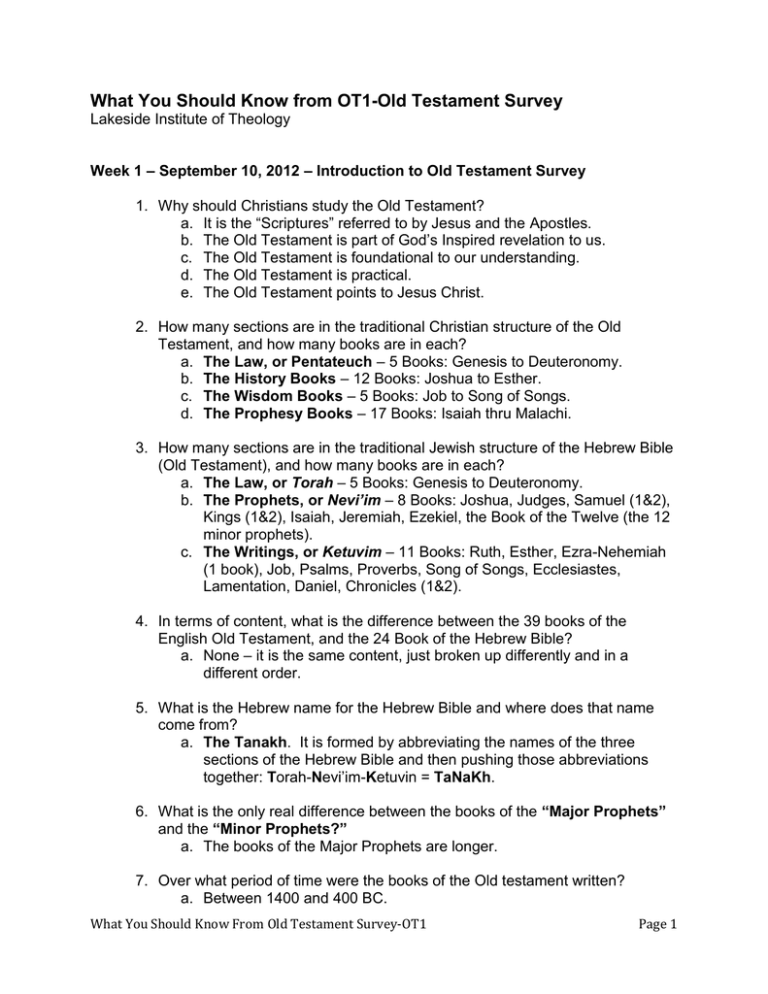
What You Should Know from OT1-Old Testament Survey Lakeside Institute of Theology Week 1 – September 10, 2012 – Introduction to Old Testament Survey 1. Why should Christians study the Old Testament? a. It is the “Scriptures” referred to by Jesus and the Apostles. b. The Old Testament is part of God’s Inspired revelation to us. c. The Old Testament is foundational to our understanding. d. The Old Testament is practical. e. The Old Testament points to Jesus Christ. 2. How many sections are in the traditional Christian structure of the Old Testament, and how many books are in each? a. The Law, or Pentateuch – 5 Books: Genesis to Deuteronomy. b. The History Books – 12 Books: Joshua to Esther. c. The Wisdom Books – 5 Books: Job to Song of Songs. d. The Prophesy Books – 17 Books: Isaiah thru Malachi. 3. How many sections are in the traditional Jewish structure of the Hebrew Bible (Old Testament), and how many books are in each? a. The Law, or Torah – 5 Books: Genesis to Deuteronomy. b. The Prophets, or Nevi’im – 8 Books: Joshua, Judges, Samuel (1&2), Kings (1&2), Isaiah, Jeremiah, Ezekiel, the Book of the Twelve (the 12 minor prophets). c. The Writings, or Ketuvim – 11 Books: Ruth, Esther, Ezra-Nehemiah (1 book), Job, Psalms, Proverbs, Song of Songs, Ecclesiastes, Lamentation, Daniel, Chronicles (1&2). 4. In terms of content, what is the difference between the 39 books of the English Old Testament, and the 24 Book of the Hebrew Bible? a. None – it is the same content, just broken up differently and in a different order. 5. What is the Hebrew name for the Hebrew Bible and where does that name come from? a. The Tanakh. It is formed by abbreviating the names of the three sections of the Hebrew Bible and then pushing those abbreviations together: Torah-Nevi’im-Ketuvin = TaNaKh. 6. What is the only real difference between the books of the “Major Prophets” and the “Minor Prophets?” a. The books of the Major Prophets are longer. 7. Over what period of time were the books of the Old testament written? a. Between 1400 and 400 BC. What You Should Know From Old Testament Survey-OT1 Page 1 8. What is the Septuagint? a. The translation of the Hebrew Bible from Hebrew into Greek, in the 3 rd Century BC. 9. Why was it so important to translate the Hebrew Bible into Greek? a. By the 3rd Century BC the Greek language had become so dominant that many young Jews had forgotten how to speak or read Hebrew, so they could no longer read their own Bible, and so a Greek translation was needed. 10. What are the Masoretic Texts? a. The “authorized version” of the Hebrew Bible (Old Testament) prepared by Jewish scholars between the 7th and 11th Centuries AD. 11. What are “vowel points” in Hebrew? a. Like most ancient written languages, Hebrew was written without vowels, since vowels are only needed to know how to pronounce the words. “Vowel points” – added by the Masoretic scholars – are dots and lines inserted around the consonants in written Hebrew to indicate the vowels, and so how to pronounce the words – and were especially useful in teaching children how to read Scripture. 12. What is the Latin Vulgate? a. The 4th Century AD translation of the Septuagint (Greek Old Testament) into Latin, made by St. Jerome, for use by the Roman Catholic Church. Week 2 – September 17, 2012 – The Pentateuch and Book of Genesis 1. What is the meaning of “Torah?” a. “Law” or “Instruction.” 2. What is the meaning of “Pentateuch?” a. The “Five Books” or “The Five Part Book.” 3. What are the five books of the Torah or Pentateuch? a. Genesis b. Exodus c. Leviticus d. Numbers e. Deuteronomy 4. According to conservative tradition, who was author of the Pentateuch? a. Moses What You Should Know From Old Testament Survey-OT1 Page 2 5. What is the meaning of the name “Genesis?” a. “Beginnings” or “origins.” 6. What are the two major sections of the Book of Genesis? a. The Prehistoric Prologue (chapters 1-11) b. The Story of the Patriarchs (chapters 12-50) 7. What are the four major events of the Prehistoric Prologue? a. The Creation b. The Fall c. The Flood d. The Tower of Babel & Dividing of Nations 8. Why are the Jewish people (and some others groups) called “Semitic?” a. They are descended from Shem, one of the three sons of Noah. 9. Who were the Hebrew Patriarchs? a. Abraham b. Isaac (Abraham’s son) c. Jacob (one of Isaac’s two sons) i. Joseph (one of Jacob’s 12 sons; technically not considered a “patriarch” by the Jews, but a major figure in their history and the focus of the last 14 chapters of Genesis.) 10. Abraham came from Mesopotamia; what does “Mesopotamia” mean? a. “The land between the rivers” – meaning the fertile land watered by the Tigris and Euphrates Rivers. 11. What is the “Fertile Crescent?” a. The arc of land that starts in Mesopotamia – the fertile area watered by the Tigris and Euphrates Rivers – and curves around through the Levant (Palestine) and down to the Nile River Delta in Egypt. It was here the first human civilizations developed. 12. What was the physical sign of God’s covenant with Abraham? a. All males were to be circumcised. 13. What new names did God give Abram (“Exalted Father”) to mark His covenant promise? a. Abraham – “Father of Many” or “Father of a Multitude (of nations)” What You Should Know From Old Testament Survey-OT1 Page 3 14. The Jewish people came from the line of Abraham’s son Isaac; who was Abraham’s other son, and what was his importance? Ishmael was actually Abraham’s firstborn, from Hagar, the handmaiden to Abraham’s wife Sarah. Ishmael went on to father twelve sons who became the twelve tribes of the Arab peoples. 15. What were the names of Isaac’s two sons? a. Jacob b. Esau 16. How did Jacob gain preeminence over his older twin brother, Esau? a. First, by talking him out of his birthright in exchange for a bowl of stew. b. Second, with encouragement from his mother Rachel, by pretending to be Esau and convincing his old and blind father Isaac to give Jacob his primary blessing. 17. What name did God give Jacob after wrestling with him all night? a. Israel, which means “He has striven (or ‘wrestled’) with God.” 18. How many sons did Jacob/Israel have, and what was their importance? a. Twelve sons, who became the founders of the “Twelve Tribes of Israel.” 19. Which of Jacob’s sons became most important, and why? a. Joseph, the 11th son, because after his brothers sold him into slavery in Egypt he rose to prominence there and later was able to save his father, brothers and their families from famine by bringing them to live in Egypt. Week 3 – September 24, 2012 – The Pentateuch; Exodus thru Deuteronomy 1. What are the two primary events recorded in the Book of Exodus? a. The Exodus itself – the miraculous delivery of the Israelites out of slavery in Egypt. b. The giving of the Law through Moses at Mount Sinai. 2. What happened at the “Burning Bush” on Mt. Horeb? a. God spoke to Moses. b. God told Moses His name. c. God called and commissioned Moses to return to Egypt to bring the Israelites out of slavery there. What You Should Know From Old Testament Survey-OT1 Page 4 3. What did God tell Moses His name was, and what does it mean? a. YHWH (or Yahweh), which means “I Am” or “I Am Who I Am.” 4. What is the “Tetragrammaton?” a. The written form of the proper name of God, YHWH, which is made up of four Hebrew letters. (“tetragrammaton” is Greek for “four letters”) 5. What was the last and most devastating of the plagues God sent against Egypt, and why did it not affect the Israelites? a. The last plague was for Death to pass through the land of Egypt, taking the lives of the firstborn of every family – including the livestock. The Israelites were not affected because they had been warned to sacrifice a lamb and to put the blood of the lamb on their doorposts and lintels, as a sign for Death to “pass over” those Jewish households – which is where we get the “Passover” as a Jewish celebration. 6. Why were the Israelites forced to wander in the desert for forty years before entering the Promised Land? a. Moses sent spies into Canaan (the Promised Land), and when they returned all of them except Caleb and Joshua said it was not possible for the Israelites to overcome the people living in Canaan, and they should not even try. This lack of faith in God’s promise meant they had to wander 40 years until every adult male of that generation – except Caleb and Joshua – had died before they could enter the Promised Land. Week 4 – October 1, 2012 – The Former Prophets 1. Why is it difficult to talk about the Old Testament as “history?” a. While much of the Old Testament tells us about events that occurred in the distant past, and these records are very valuable, we must remember that the ancient Hebrews had a different way of looking at how history was written. Our modern idea of history – a sequential, systematic and usually objective record of events – was invented by Greek historian Herodotus in the 5th Century BC – which means almost all the Old Testament was written before the invention of what we think of as “history.” What You Should Know From Old Testament Survey-OT1 Page 5 2. What is the proper definition of a “prophet?” a. One who speaks for God and interprets His will to the people. So “to prophesy” means to communicate God’s will and His words to people, whether that relates to events happening in the past, the present, or the future. 3. Which books makes up the Former Prophets, according to the Hebrew Bible? a. Joshua b. Judges c. Samuel (1&2) d. Kings (1&2) 4. Why did the Jews consider these books, which Christians call “historical,” to be prophetic books? a. These books record God’s actions in fulfilling His covenant promises, and so in that regard are “prophetic.” Perhaps they are best understood as “historic events from a prophetic perspective.” 5. What is the main focus of the book of Joshua? a. The conquest of the Promised Land by the Israelites, and the settling of the Tribes of Israel into the land. 6. What is the main focus of the book of Judges? a. How God raised up and used heroes (“judges”) to lead the Israelites in defeating various enemies that were oppressing them in Canaan. 7. What is the main focus of the 2 books of Samuel? a. How God used the Prophet Samuel to establish a monarchy in Israel; the anointing and eventual failure of King Saul; and the anointing and reign of King David. 8. What is the main focus of the 2 books of Kings? a. The reign of David’s son Solomon, the building of the Temple and palace in Jerusalem; Solomon’s decline and the divided Kingdom, and the reign of all the kings. 9. What were the names of the Divided Kingdoms after Solomon? a. The Northern Kingdom of Israel, with its capital in Samaria. b. The Southern Kingdom of Judah, with its capital in Jerusalem. What You Should Know From Old Testament Survey-OT1 Page 6 10. Why did God eventually allow the two Divided Kingdoms to be destroyed? a. For worshipping other gods. 11. How and when were the two Kingdoms destroyed? a. The Northern Kingdom of Israel was destroyed by the Assyrians in 722 BC and the people carried off into slavery, never to be heard from again. (The Ten Lost Tribes of Israel.) b. The Southern Kingdom, which was a little better and had a few good kings, lasted until 586 BC, when they were conquered by the Babylonians. But the Babylonians allowed the Jews to stay intact in groups, so these were the Jews that eventually returned to Israel. Week 5 – October 8, 2012 – The Latter Prophets 1. Who is considered the first true Old Testament prophet, and the prototype for all prophets who followed? a. Moses. 2. Who were considered the “Major Prophets?” a. Isaiah b. Jeremiah c. Ezekiel 3. Who were considered the “Minor Prophets?” a. The Book of the Twelve, the twelve prophets who wrote much shorter books – Hosea through Malachi. 4. Besides “Major and Minor” or “Former and Latter,” what other useful way may we divide up the Old Testament prophets? a. The “Oral Prophets” are those who came earlier and left no writing – including some very important prophets like Nathan, Jehu, Elijah, and Elisha. b. The “Writing (or Literary) Prophets” who contributed books to the Bible. 5. Most of the Literary Prophets prophesied to the Southern Kingdom of Judah; which two were sent to the Northern Kingdom of Israel? a. Hosea b. Amos What You Should Know From Old Testament Survey-OT1 Page 7 Week 6 – October 15, 2012 – The Writings 1 1. What are the three divisions of the Ketuvim, or “Writings,” in the Hebrew Bible and which books are included in each? a. The Books of Truth, or Poetic Books: Psalms, Proverbs, Job. b. The “Five Scrolls” or Megillot: Song of Songs, Ruth, Lamentations, Ecclesiastes, Esther. c. Other Writings (sometimes called the “Historical Books”): Daniel, EzraNehemiah, Chronicles (1&2). 2. What is the theme and purpose of the Book of Psalms. a. Prayer and Worship; how we relate to God. 3. Who was author of the largest number the 150 Psalms? a. King David. 4. What is “The Hallel,” and what does the word mean? a. Psalms 113-118, which are special Psalms of Praise meant to be read publically at Jewish religious feasts and festivals. “Hallel” means “praise” – it’s where we get the word “hallelujah.” 5. What is the theme and purpose of the Book of Proverbs. a. Wisdom for living a good life. 6. What is the theme and purpose of the Book of Job. a. To help us understand suffering, especially undeserved suffering. 7. What is unique about the “Five Scrolls” or “Five Megillot?” a. They are each intended to be read aloud at different Jewish festivals. i. Song of Songs is read at Passover. ii. Ruth is read at Shabuot (Pentecost). iii. Lamentations is read at the commemoration of the destruction of the Temple. iv. Ecclesiastes is read at the Feast of Tabernacles, commemorating the Desert Sojourn of the Jews before entering the Promised Land. v. Esther is read at Purim, the celebration of the saving of the Jews when threatened with destruction by evil Haman. What You Should Know From Old Testament Survey-OT1 Page 8 Week 7 – October 22, 2012 – The Writings 2 1. Why was the Babylonian Exile so traumatic to the Jews? a. They were left wondering if God still loved them and if they were still His special people. b. They were unsure how to be the people of God when the things that had most represented their election as God’s people – the Promised Land and the Temple – had been taken away or destroyed. c. They did not know how to worship without a Temple. d. They were fearful of being assimilated and losing their uniqueness as a people – as had happened to the tribes in the Northern Kingdom of Israel when Assyrian had conquered them 136 years earlier. 2. What is the main theme of the Book of Lamentations? a. Sorrow over the destruction of the city of Jerusalem and the Temple by the Babylonians in 586 BC. 3. Who is believed to have been the author of Lamentations? a. The Prophet Jeremiah. 4. What is unusual about the structure of Lamentations? a. There are five poems (one per each chapter) with the first four of these written as acrostics – the first, second and fourth chapters have 22 verse (the same as the number of letters in the Hebrew alphabet), with each verse starting with a letter of the Hebrew alphabet taken in order. The third chapter has 66 verses, or three times the number of Hebrew letters, with each three successive verses beginning with the same letter. 5. What are the lessons learned from Lamentations? a. God is sovereign over the affairs of men, even when he uses empires and armies to enact His will. b. Sin can bring tragic consequences. c. There is hope even in the worst darkness. 6. How did Daniel and his friends come to be living in the city of Babylon? a. After King Nebuchadnezzar of Babylon defeated the Egyptian and Assyrian armies at Carchemish, he pursued the Egyptians back down towards Egypt to ensure they were defeated – which took him right through the Kingdom of Judah. He proceeded to conquer this small kingdom before returning home to Babylon. What You Should Know From Old Testament Survey-OT1 Page 9 7. How many times were groups of Hebrew people deported by the Babylonians, and what was noteworthy about each? a. There were THREE deportations: i. 605 BC – 1st Deportation, when Nebuchadnezzar first conquers Judah and takes captives back to Babylon – including young nobleman Daniel and his friends Hananiah, Mishael and Azariah (who became Shadrach, Meshach and Abednego), to make them officials in his court. ii. 597 BC – 2nd Deportation, which included the Prophet Ezekiel. iii. 586 BC – 3rd deportation, when the Temple and City of Jerusalem are3 destroyed. 8. What was the meaning of Nebuchadnezzar’s dream of a great statue that Daniel interpreted? a. The statue represented the Babylonian Kingdom and other kingdoms which were to come – Persians, Greeks, and either the Seleucids under Antiochus or the Romans. 9. Who defeated the Babylonian Empire? a. The Persian Empire, under King Cyrus the Great. 10. What did King Cyrus the Great of Persia do for the Jews almost immediately? a. He gave permission to return to Jerusalem and rebuild the Temple. 11. What are some of the unusual features of the Book of Daniel? a. It is written partly in Hebrew and partly in Aramaic (or Chaldean) – the Babylonian language. b. It is an Apocalyptic Book, but it also has parts that seem like history, and other parts that seem prophetic. c. It makes rather specific prediction about coming events, including the coming of future world empires. 12. What is the meaning of “apocalypse” or “apocalyptic?” a. “Apocalypse” is from the Greek word meaning “revelation” and so means the revealing of something – especially something that was hidden, or that could not have been known without the revelation. 13. How many events of “return” are described in the book of Ezra-Nehemiah? a. There are three “return” events: What You Should Know From Old Testament Survey-OT1 Page 10 i. Zerubbabel is sent (by Persian King Cyrus) as governor with companions to begin rebuilding the Temple in Jerusalem (Ezra 16). ii. Ezra is sent (by Persian King Darius) with companions to teach the people the Law – and to encourage them to restart the building project. (Ezra 7-10) iii. Nehemiah is given permission (by Persian King Artaxerxes) to return to rebuild the city walls (all of Book of Nehemiah). What You Should Know From Old Testament Survey-OT1 Page 11
